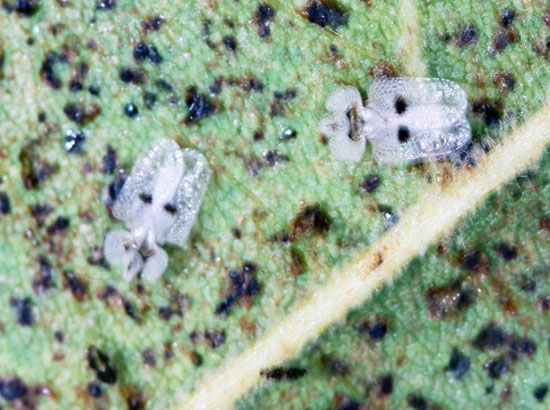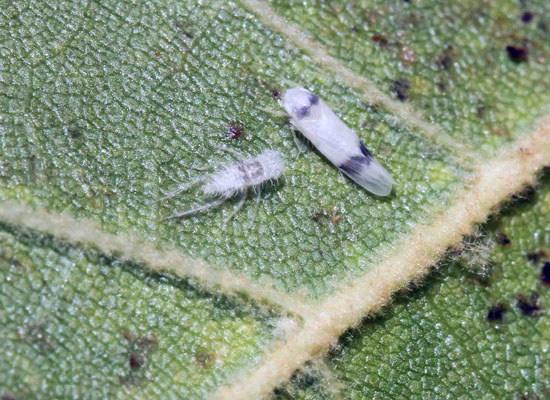Issue 16, September 23, 2013
Sycamore Lacebug and Leafhoppers
Sycamore leaves are attacked by several piercing-sucking insects that cause stippling of the leaves. As the insect populations rise and fall and weather conditions vary, this aesthetic damage can be more or less noticeable. This year, the damage by these insects is quite noticeable.
Stippling appears as whitish dots on the leaf upperside due to the cell contents, including the green chlorophyll, being removed by the lacebug or leafhoppers on the underside. On sycamore, the damage is more noticeable along leaf veins, as both lacebug and leafhopper nymphs seem to prefer those areas. Heavier feeding results in elongated patches of collated stipples along vein, with the central 50% or more of the leaf turning whitish in years and areas with high infestations.

Stippling damage on sycamore leaf.
Sycamore lacebug, Corythuca ciliate, feeds on the underside of sycamore leaves. Their presence is easily recognized by the numerous tiny black spots, lacebug feces, on the leaf undersides. The 1/8-inch-long, flattened adults with white, lacy wings are on the underside near major veins, along with the smaller, blackish, diamond-shaped nymphs. Adults overwinter under loose bark, emerging in spring to lay eggs on the undersides of expanding leaves. It takes about 30 days for the bugs to progress from egg to adult, allowing several generations per year. Two to four generations per year apparently occur in Illinois.

Sycamore lacebug adults on sycamore.

Sycamore lacebug nymphs on sycamore.
At least three species of leafhoppers in the genus Erythroneura attack sycamore leaves. Green, white, and white and black banded adults along with nymphs can be found on leaf undersides, particularly along veins. Leafhopper nymphs and adults also suck out cell contents, causing additional stippling on the leaf uppersides. They do not produce the black, tar-like feces like lacebugs nor cause leaf distortion like potato leafhopper on red maple. They produce honeydew, resulting in leaves with glossy, sticky areas. If sycamore leaves have white stippling on the uppersides without black spots on the undersides, the damage was probably caused by leafhoppers. If leafhoppers are not present, look for their clear cast skins adhered to the leaf underside by honeydew. Adult leafhoppers overwinter as adults under leaves and loose bark, laying eggs in the expanding leaves in the spring. There are usually two generations per year.

Sycamore leafhopper adults on sycamore.

Leafhopper adult and exuvium on sycamore.
Damage is typically limited to stippling and black fecal spots. This aesthetic injury can usually be accepted without the need for control. Heavily attacked leaves appear to drop earlier in the fall, but unattacked leaves soon follow. If control is needed, a spray application of cyfluthrin (Tempo) or other labeled pyrethroid should be effective. However, sycamores are very large trees with drift likely during a spray application. A systemic insecticide such as clothianidin (Arena) or thiamethoxam (Meridian) should also be effective. (Phil Nixon)
Author:
Phil Nixon